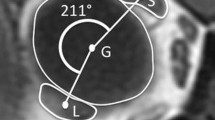Abstract
Purpose
To evaluate intraocular pressure (IOP) at different gaze positions in patients with highly myopic strabismus (HMS).
Study design
Nonrandomized, prospective, observational study.
Methods
This study included 18 eyes of 14 patients with HMS and 51 eyes of 51 age-matched controls without strabismus; these were further divided into two groups based on refractive errors: > -6.00 diopter (D) (n = 22 eyes) and ≤ -6.00 D (n = 29 eyes). IOP was measured in primary and side gazes and compared within and among groups. The relationships between IOPs and axial length, angle of globe dislocation measured on magnetic resonance imaging, strabismus angle, and degree of abduction deficit were studied.
Results
The HMS group showed higher IOP in abduction (19.3 ± 4.9 mmHg) than in the primary (12.5 ± 4.3 mmHg) and adducting positions (13.0 ± 3.3 mmHg), (p < 0.001). The IOP in the adducting position in the HMS group (13.0 ± 3.3 mmHg) was lower than in the control groups both with (17.6 ± 3.5 mmHg) and without (16.9 ± 4.1 mmHg) high myopia, ; (p < 0.001 and = 0.003). The difference in IOP between abduction and adduction was significantly larger in the HMS group (6.4 ± 4.6 mmHg) compared to others (p < 0.001) and positively correlated with the strabismus angle and the angle of globe dislocation and negatively with abduction deficit.
Conclusion
The IOP of patients with HMS changes dramatically on side gazes, therefore, care should be taken while measuring IOP.




Similar content being viewed by others
Data availability
The data that support the findings of this study are available on request from the corresponding author, [M.S.].
References
Yokoyama T. Myopic strabismus: A surgical strategy derived from pathophysiological imaging studies. Proceedings book XIIth ISA meeting: advances in strabismus; 2014. pp. 9–20.
Kim YJ, Moon Y, Kwon AM, Lim HW, Lee WJ. Intraocular pressure according to eye gaze by iCare rebound tonometry in normal participants and glaucoma patients. J Glaucoma. 2021;30:643–7.
Danesh-Meyer HV, Savino PJ, Deramo V, Sergott RC, Smith AF. Intraocular pressure changes after treatment for Graves’ orbitopathy. Ophthalmology. 2001;108:145–50.
Currie ZI, Lewis S, Clearkin LG. Dysthyroid eye disease masquerading as glaucoma. Ophthalmic Physiol Opt. 1991;11:176–9.
Gomi CF, Yates B, Kikkawa DO, Levi L, Weinreb RN, Granet DB. Effect on intraocular pressure of extraocular muscle surgery for thyroid-associated ophthalmopathy. Am J Ophthalmol. 2007;144:654–7.
Saunders RA, Helveston EM, Ellis FD. Differential intraocular pressure in strabismus diagnosis. Ophthalmology. 1981;88:59–70.
Haneda S, Kanno M, Sato M, Oonuma I, Yamashita H. A case of myopic strabismus fixus with increased intraocular pressure. Proceedings book XIth ISA meeting: update on Strabismology 2010:497–501.
Hayashi S, Sato M, Miura H, Sugano A, Yamazaki M, Yamashita H. Intraocular pressure decreases after muscle union surgery for highly myopic strabismus. Jpn J Ophthalmol. 2015;59:118–23.
Yamaguchi M, Yokoyama T, Shiraki K. Surgical procedure for correcting globe dislocation in highly myopic strabismus. Am J Ophthalmol. 2010;149:341–6.e2.
Flitcroft DI, He M, Jonas JB, Jong M, Naidoo K, Ohno-Matsui K, et al. IMI – Defining and classifying myopia: A proposed set of standards for clinical and epidemiologic studies. Invest Ophthalmol Vis Sci. 2019;60:M20–30.
Thompson JT, Guyton DL. Ophthalmic prisms. Measurement errors and how to minimize them. Ophthalmology. 1983;90:204–10.
van den Bosch JJON, Pennisi V, Invernizzi A, Mansouri K, Weinreb RN, Thieme H, et al. Implanted microsensor continuous IOP telemetry suggests gaze and eyelid closure effects on IOP-A preliminary study. Invest Ophthalmol Vis Sci. 2021;62:8.
Demer JL, Clark RA, Suh SY, Giaconi JA, Nouri-Mahdavi K, Law SK, et al. Optic nerve traction during adduction in open angle glaucoma with normal versus elevated intraocular pressure. Curr Eye Res. 2020;45:199–210.
Acknowledgements
We thank Editage for English language editing.
Funding
JSPS KAKENHI Grant Number, 16K11264.
Author information
Authors and Affiliations
Corresponding author
Ethics declarations
Conflict of interest
S. Arai, None; H. Suzuki, None; S. Hayashi, None; R. Inagaki, None; T. Haseoka, None; A. Hikoya, None; M. Komori, None; T. Shimizu, None; N. H. Muhammad, None; Y. Hotta, None; M. Sato, None.
Additional information
Publisher’s note
Springer Nature remains neutral with regard to jurisdictional claims in published maps and institutional affiliations.
Corresponding Author: Miho Sato
About this article
Cite this article
Arai, S., Suzuki, H., Hayashi, S. et al. Intraocular pressure at different gaze positions in patients with highly myopic strabismus. Jpn J Ophthalmol 66, 572–578 (2022). https://doi.org/10.1007/s10384-022-00939-8
Received:
Accepted:
Published:
Issue Date:
DOI: https://doi.org/10.1007/s10384-022-00939-8




